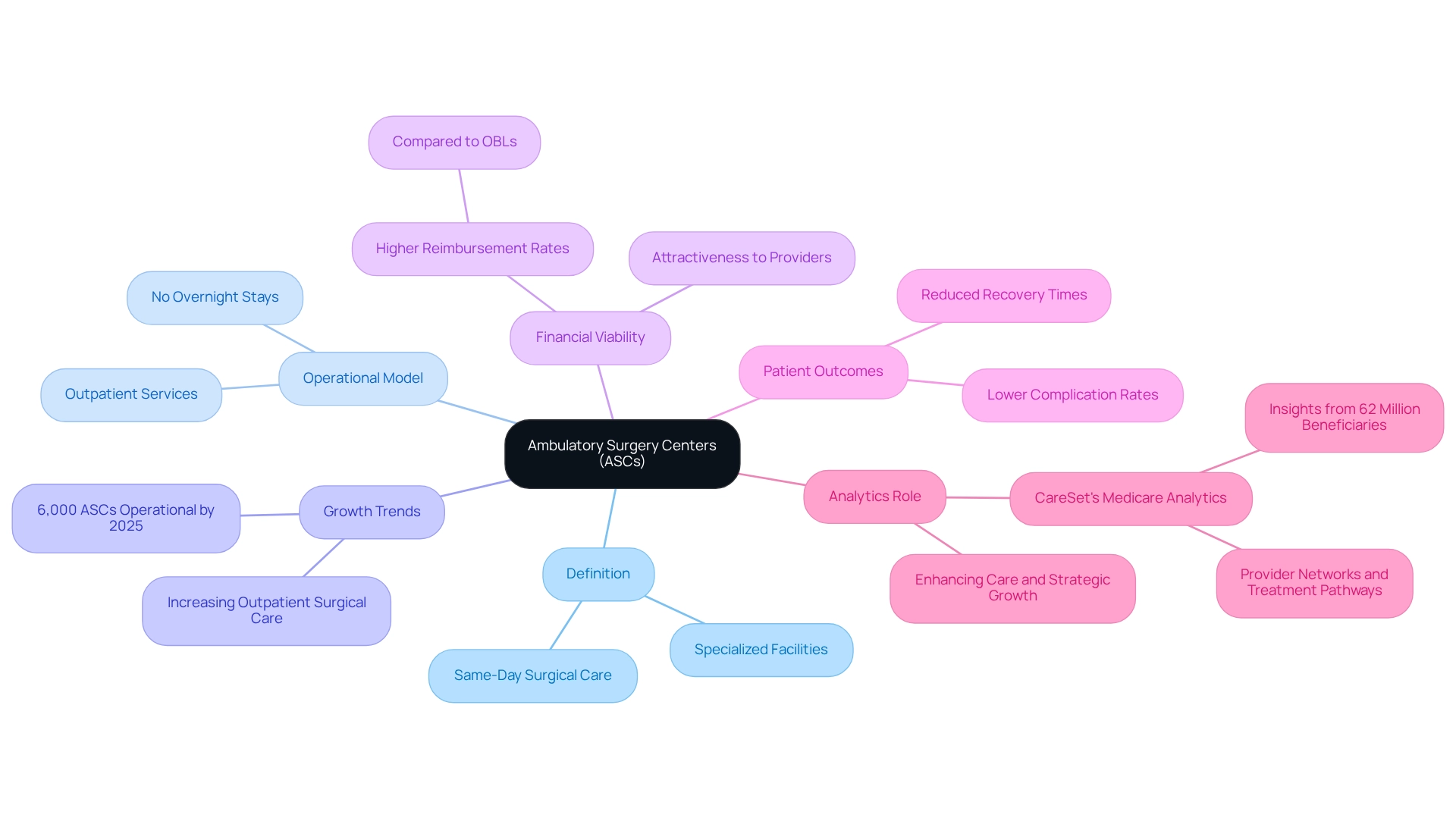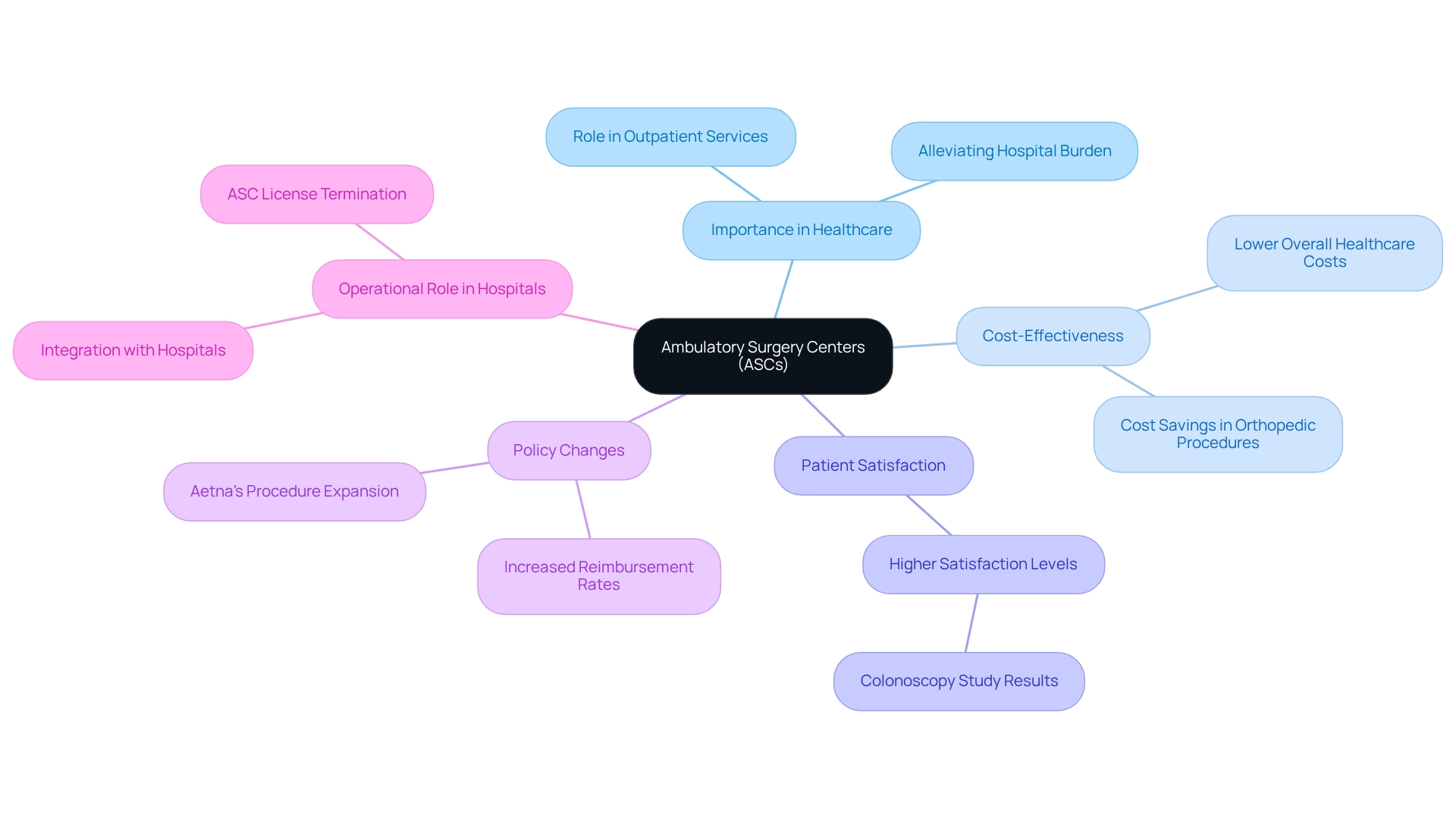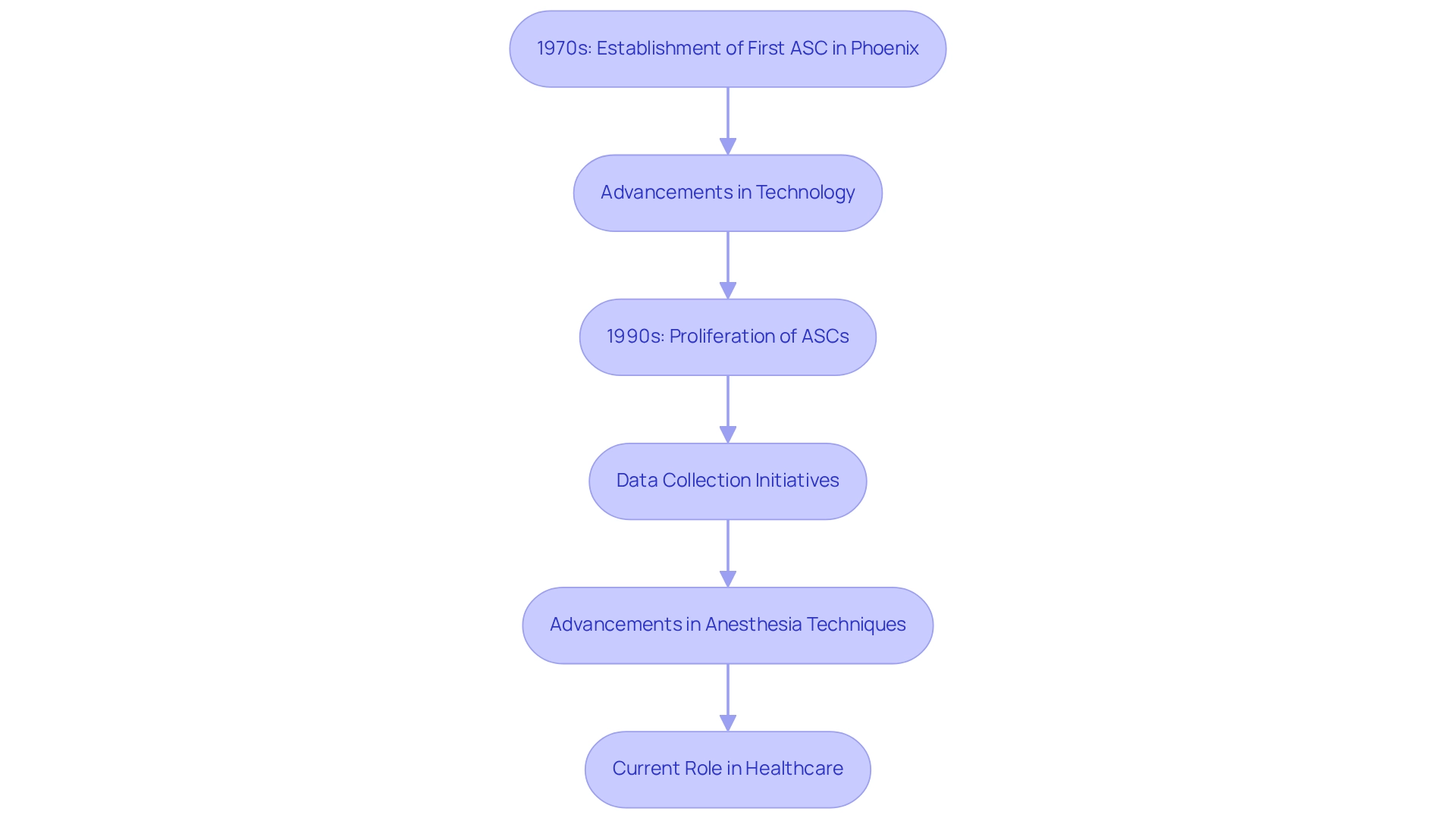Overview
The abbreviation ASCs refers to Ambulatory Surgery Centers, specialized facilities dedicated to providing same-day surgical care. These centers focus on outpatient services, significantly enhancing patient convenience and operational efficiency. The article highlights how ASCs contribute to improved patient outcomes, evidenced by reduced recovery times and higher satisfaction rates. Financial viability is also a key aspect, driven by favorable reimbursement rates and strategic healthcare policies. This information underscores the essential role of ASCs in modern healthcare, prompting further exploration of their impact on patient care.
Introduction
In the evolving landscape of healthcare, Ambulatory Surgery Centers (ASCs) have emerged as pivotal players, revolutionizing the delivery of surgical care. These specialized facilities provide a streamlined approach to outpatient surgeries, enabling patients to undergo procedures and return home the same day. This not only enhances convenience but also reduces costs, making ASCs increasingly relevant as the demand for efficient healthcare solutions rises.
As they gain traction, ASCs are reshaping patient expectations and the overall healthcare delivery system. With a significant increase in their numbers and the support of favorable reimbursement policies, ASCs are positioned to play a crucial role in improving patient outcomes and optimizing resource allocation.
This article delves into the defining features, historical evolution, and strategic importance of ASCs in modern healthcare, highlighting their contributions to a more efficient and patient-centric system.
Define ASCs: Understanding the Medical Abbreviation
Ambulatory Surgery Centers (ASCs), often referred to by the ASCs medical abbreviation, are specialized medical facilities that deliver same-day surgical care, encompassing both diagnostic and preventive procedures. Unlike conventional hospitals, ASCs emphasize outpatient services, enabling individuals to undergo surgery and return home on the same day, thus eliminating the need for overnight stays. This model not only enhances patient convenience but also optimizes surgical workflows, contributing to a more efficient medical delivery system.
As of 2025, approximately 6,000 ambulatory surgical centers are operational across the United States, indicating a significant growth trend in outpatient surgical care. Recent statistics reveal that reimbursement rates for ASCs are generally higher than those for Office-Based Laboratories, highlighting their financial viability and attractiveness to medical providers. This elevated reimbursement rate is a crucial factor that reinforces the strategic importance of ASCs within the healthcare landscape.
The successful implementation of ASCs has been linked to improved outcomes for patients, with research showing reduced recovery times and lower complication rates compared to traditional inpatient surgeries. Engaging with payors early in the development process is essential for ASCs to secure in-network status and clarify operational frameworks, as payors may be reluctant to contract if they foresee potential cost increases. As Chris DeGrande remarked, “Payors are less likely to contract with providers if they believe that a proposed arrangement is likely to result in higher costs to members.” This proactive approach not only mitigates contracting challenges but also ensures that ASCs can effectively serve their clientele while maintaining cost efficiency.
In this context, CareSet’s advanced Medicare analytics play a pivotal role in revealing provider networks, treatment pathways, and insights into the patient journey. By leveraging insights from over 62 million beneficiaries and 6 million providers, CareSet empowers healthcare organizations to make informed decisions that enhance care and foster strategic growth. Furthermore, CareSet is committed to upholding the highest standards of individual privacy and protection, ensuring that all analytics are conducted with the utmost regard for confidentiality.
In conclusion, the ASCs medical abbreviation refers to Ambulatory Surgical Centers, which are essential to the outpatient care landscape by offering high-quality surgical services that improve patient experiences and outcomes. Their comprehensive approach addresses urgent data needs and supports long-term strategic development, establishing them as a critical component of modern medical services.

Contextualize ASCs: Importance in Healthcare Delivery
Ambulatory Surgery Centers, commonly known by the ASCS medical abbreviation, are increasingly recognized as essential components of the modern healthcare delivery system, offering a cost-efficient alternative to traditional hospital-based surgeries. These facilities specialize in a range of surgical procedures, particularly those that are less complex and do not require extensive post-operative care. The rising preference for outpatient services signifies a shift in patient expectations, as individuals seek more convenient and affordable surgical options.
The expansion of Ambulatory Surgical Centers (ASCs), often referred to by the ASCS medical abbreviation, has been significantly influenced by recent policy changes from commercial payers, which now promote the use of these facilities for outpatient surgical procedures. Increased reimbursement rates and requirements for members to utilize ambulatory surgical centers unless hospital care is medically necessary are driving more surgical procedures to these facilities. This transition not only enhances the role of Ambulatory Surgical Centers, commonly referred to by the ASCS medical abbreviation, within the healthcare system but also has the potential to lower overall healthcare costs. Notably, a recent study highlighted considerable cost reductions in outpatient orthopedic procedures performed in ambulatory surgical centers, which are often referred to by the ASCS medical abbreviation, further affirming their cost-effectiveness.
A 2021 study published in the Ambulatory Surgery Journal revealed that individuals undergoing colonoscopy in Ambulatory Surgical Centers reported significantly higher satisfaction levels compared to those treated in outpatient hospitals. This finding underscores the quality of care provided in ambulatory surgical centers, further supported by the fact that a substantial proportion of outpatient surgeries—projected to reach approximately 70% by 2025—are currently performed in these facilities.
Moreover, Ambulatory Surgical Centers alleviate the burden on hospitals, enabling them to concentrate on more complex cases and improving patient flow within the medical system. As one expert observed, “Even if an ASC is not physically located next to a hospital, once it is part of a hospital, it can terminate its ASC license and become a unit of the hospital.” This statement emphasizes the operational connections between ambulatory surgical centers and hospitals, highlighting the importance of these facilities in the broader medical landscape, which is often referred to by the ASCS medical abbreviation. Additionally, Aetna’s recent expansion of the list of procedures eligible for completion in ambulatory surgical centers without precertification reflects the evolving acceptance of these facilities within the healthcare system.
As the ASCS medical abbreviation represents Ambulatory Surgery Centers, their evolving role in medical service delivery becomes increasingly evident, not only in terms of cost-effectiveness but also in enhancing patient outcomes and optimizing resource allocation within hospitals.

Trace the Origins: Historical Development of ASCs
The concept of Ambulatory Surgery Centers (ASCs), often referred to by the ascs medical abbreviation, emerged in the early 1970s, marked by the establishment of the first center by two physicians in Phoenix, Arizona. This groundbreaking model aimed to provide high-quality, cost-effective surgical alternatives outside traditional hospital environments, often referenced in discussions about the ascs medical abbreviation.
Over the years, ASCs, often referred to by the ascs medical abbreviation, have undergone significant evolution, propelled by advancements in medical technology, shifting consumer preferences, and the increasing demand for efficient medical service delivery. By the 1990s, the ascs medical abbreviation gained considerable momentum, with ASCs proliferating across the United States, reflecting a broader transition towards outpatient care within the healthcare landscape.
This shift not only aligns with the changing needs of patients but also underscores the growing recognition of ASCs, often referred to by the ascs medical abbreviation, as vital components of contemporary medical service delivery systems. According to the Healthcare Cost and Utilization Project (HCUP), which provides a comprehensive database for analyzing significant outpatient surgeries, the growth of ASCs, referenced by the ascs medical abbreviation, has been supported by extensive data collection initiatives.
CareSet integrates over 100 external data sources, including Medicare information, emphasizing the critical role of data in understanding the evolution of ASCs, which is relevant to the ascs medical abbreviation, and their impact on medical service delivery. By leveraging these insights, medical stakeholders can refine their strategies and enhance patient care outcomes.
Furthermore, advancements in ambulatory anesthesia techniques—such as general, regional, and the ascs medical abbreviation for monitored anesthesia care—have further expanded the capabilities of surgical centers, enabling them to offer a wider array of surgical services.
The case study titled ‘Trends in Ambulatory Surgery Data Collection’ illustrates how data collection has evolved and its impact on healthcare delivery, highlighting the significance of the ascs medical abbreviation within the healthcare system and demonstrating how CareSet’s data solutions empower stakeholders to navigate this complex environment.

Identify Key Characteristics: Functions and Features of ASCs
The ascs medical abbreviation refers to Ambulatory Surgery Centers (ASCs), which are distinguished by several key features that significantly enhance operational efficiency and patient care.
- Same-Day Discharge: These facilities enable patients to undergo procedures and return home on the same day, effectively minimizing hospital stays and associated costs. This practice is supported by a denial rate of under 5%, underscoring the centers’ effectiveness in managing patient flow. Additionally, CareSet’s Medicare insights can further enhance this efficiency by providing analytics on individual outcomes and discharge processes.
- Specialized Services: Many ASCs concentrate on specific types of surgeries, such as orthopedic, ophthalmologic, and gastroenterological procedures. This specialization allows for tailored care that meets the unique needs of patients in these areas. By leveraging CareSet’s data, ambulatory surgical centers can identify trends and optimize their service offerings based on patient demographics and requirements, which relates to the ascs medical abbreviation. For example, the revenue per case for gastroenterology procedures is approximately $800. Moreover, key financial indicators reveal that salaries and benefits account for 23% of net revenue, while supply expenses are 27.8%, reflecting the financial health and effective resource management of ASCs, which is often summarized by the ascs medical abbreviation. CareSet’s insights can assist these centers in benchmarking their costs against industry standards, ensuring they maintain competitiveness.
- Streamlined Processes: Designed for efficiency, ASCs feature dedicated operating rooms and staff specifically trained for outpatient procedures. This focus results in shorter wait times and improved experiences for patients, contributing to higher satisfaction rates. Furthermore, the ascs medical abbreviation reflects that ASCs maintain a clean claims rate of 98%, highlighting their reliability in managing claims effectively. By utilizing CareSet’s information analytics, ASCs can further refine their processes and enhance operational workflows.
These attributes not only elevate patient satisfaction but also optimize resource utilization, thereby increasing the overall efficiency of the healthcare system. CareSet’s comprehensive approach addresses immediate data needs and promotes long-term strategic growth for healthcare partners, ensuring they can adeptly navigate the complexities of the healthcare landscape.

Conclusion
The rise of Ambulatory Surgery Centers (ASCs) signifies a pivotal transformation in the healthcare landscape, presenting a streamlined, cost-effective alternative to traditional hospital surgeries. By enabling same-day discharge and emphasizing outpatient procedures, ASCs respond to the increasing demand for convenience and efficiency in surgical care. This model not only enhances patient satisfaction but also alleviates the burden on hospitals, allowing them to focus on more complex cases.
The historical development of ASCs illustrates their evolution from a novel concept in the 1970s to essential components of modern healthcare. With advancements in medical technology and supportive policy changes, ASCs have gained recognition for their role in improving patient outcomes and optimizing resource allocation within the healthcare system. The integration of data analytics, such as those provided by CareSet, further empowers ASCs to refine their operations and elevate patient care.
As the number of ASCs continues to expand, their significance in the healthcare delivery system becomes increasingly evident. They embody a shift towards more patient-centric care that prioritizes efficiency, quality, and cost-effectiveness. By adopting the ASC model, healthcare providers can meet the evolving expectations of patients while contributing to a more sustainable healthcare environment. The future of surgical care lies in the ongoing expansion and innovation of ASCs, rendering them indispensable in the pursuit of improved healthcare delivery.


